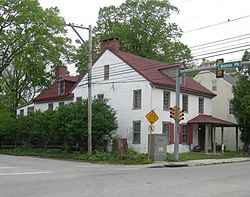Hovenden House, Barn and Abolition Hall
|
Hovenden House, Barn and Abolition Hall
|
|

Maulsby-Corson-Hovenden House (built 1767).
|
|
| Location | 1 E. Germantown Pike, Plymouth Meeting, Whitemarsh Township, Pennsylvania |
|---|---|
| Coordinates | 40°6′10″N 75°16′41″W / 40.10278°N 75.27806°WCoordinates: 40°6′10″N 75°16′41″W / 40.10278°N 75.27806°W |
| Area | 9 acres (3.6 ha) |
| Built | 1767, c.1795, 1856 |
| Built by | Samuel Maulsby (house & barn) George Corson (Abolition Hall) |
| Architectural style | Federal |
| NRHP Reference # | 71000713 |
| Significant dates | |
| Added to NRHP | February 18, 1971 |
| Designated PHMC | November 18, 2000 |
|
|
Hovenden House, Barn and Abolition Hall is a group of historic buildings in Plymouth Meeting, Whitemarsh Township, Montgomery County, Pennsylvania. The property was an important station on the Underground Railroad. Abolition Hall served as a meeting place for abolitionists, and later as the studio of artist Thomas Hovenden.
The house is located at the northeast corner of Germantown and Butler Pikes, opposite the Plymouth Friends Meetinghouse. Northeast of the house is the stone barn, and attached to the barn's east wall is the 2-story carriage house known as Abolition Hall. The three buildings are part of a 10.45-acre farm, and are contributing properties in the Plymouth Meeting Historic District.
A 2-story stone house was built at the corner of Germantown and Butler Pikes in 1767. Samuel Maulsby (1768–1838) purchased the house on 126 acres (51 hectares) in February 1794, and established quarries and a lime-making business. He enlarged the house into a 3-story, 14-room, Federal-style dwelling, built the stone barn (c.1795), and is presumed to have built the carriage shed. He married Susanna Thomas (1780–1818), and they had seven children. Their daughter Martha (1807–1870) married George Corson (1803-1860) in 1832. Maulsby died in 1838, and the couple purchased the farm from his estate the following year. George and his brothers bought the quarries, and founded what became G. & W. H. Corson Company - Lime Merchants.
The Fugitive Slave Act of 1793 made it a federal crime to give assistance to an escaped slave.
The earliest and only abolitionists in Plymouth and Whitemarsh townships were Samuel Maulsby, Joseph Corson and Alan W. Corson. Away back before 1820 they had been stirred by the scathing denunciations of slavery, and the horrors of the slave trade, made by Granville Sharp, William Wilberforce and Thomas Fouell Buxton, before the Parliament of Great Britain, to an intense hatred of slavery and the slave trade, and the abominations of slavery in our own country.
...
Wikipedia


